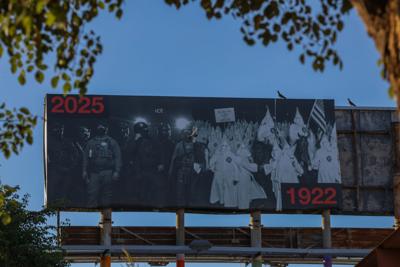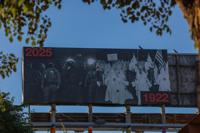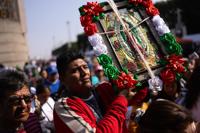
Karen Fiorito's "We Stand for Law and Order" is displayed on the corner of Grand Avenue and Fillmore Street on Sunday, Sept. 28, 2025, in Phoenix, Arizona. (Lorenzo Gomez/CALÓ News)
There is no shortage of billboards in the Valley. Locals are accustomed to seeing the abundance of “RAFI!” signs and fast-food advertisements. But where Fillmore Street meets Grand Avenue, there may be a specific billboard that will catch your eye.
On Aug. 25, Karen Fiorito, in collaboration with the Grand Avenue Billboard Project, put up an art installation depicting Immigration and Customs Enforcement (ICE) agents and members of the Ku Klux Klan standing side-by-side, both ominously masked, hiding their identities. In bold: “1922” and “2025”.
“It’s just kind of our way of fighting back and saying ‘this isn’t normal’,” Fiorito told CALÓ News.
The billboard, titled “We Stand for Law & Order,” was constructed by piecing together elements from found photographs, using AI to refine the lighting before editing the elements into a cohesive final image. Its purpose, she said, was to not only bring awareness to President Donald Trump’s mass deportation agenda, but also to illustrate the parallels between now and a time when racial profiling and violence were widely accepted and embraced, while the perpetrators hid behind masks.
According to their website, ICE agents wear masks to prevent doxxing, although Arizona Attorney General Kris Mayes says only her special agents wear masks in “very rare circumstances.” In July, Mayes publicly denounced the agency’s use of masks, especially with increased instances of people posing as ICE agents attempting to detain people illegally.
“I see a direct correlation between the fear and intimidation, the way that masks are used to provoke fear and intimidation and the targets being marginalized communities,” the long-time artist said.
Fiorito wears many hats. She is the president of the Los Angeles Printmaking Society, a teacher at Fallbrook Center for the Arts and, of course, a full-time artist. When she met Beatrice Moore, who owns the billboard, in 2003 while studying at Arizona State University, she already had an idea in mind. She said, “‘Hi, I’m Karen, a political artist, and I want to borrow your billboard.’”
More than 20 years later, they have collaborated on numerous projects using provocative political art, all with the same two-sided billboard just outside of downtown Phoenix. Earlier this year, Fiorito designed a billboard depicting Trump as a “Swamp King” shortly after Alligator Alcatraz — a now-closed immigration detention center — opened its doors in Florida. It included satirical portrayals of the “Big Beautiful Bill” and a Tesla Cybertruck spray-painted with a swastika.
Moore says it’s a matter of free speech.
“It’s like any form of artwork," she said, “Some people are gonna like it and some people are gonna hate it, and if someone were to comment to me about it and not like it, my comment would be, well, we didn’t put it up necessarily for you to like it.”
Both Fiorito and Moore face consistent threats of violence, dating back to some of their first projects together. At one point, Fiorito said far-right media outlets doxxed her for a billboard criticizing Fox News.
Their bold thinking comes at a time when many feel free speech is under attack. In mid-September, ABC and Disney decided to pull Jimmy Kimmel’s late-night talk show off the air after making comments about how Trump and other conservatives seemed to be handling the fallout of right-wing podcaster Charlie Kirk’s death. The decision resulted in backlash from the public audience about censorship and satire, a form of speech protected under the First Amendment.
The show has since resumed, but the incident raised concerns over how the Trump administration is addressing free speech — an issue the president himself has claimed is under threat.
“It's core political speech, which is protected under the Constitution. If you criticize any kind of government official, that's core protected speech,” Fiorito said about the billboard.
Its message, she says, is more relevant than ever, as Arizona has become a hotspot for immigration enforcement activity.
As of Sept. 15, about 2,700 people are in ICE detention in the state, ranking fifth in the country, according to the Transnational Records Access Clearinghouse at Syracuse University. On top of that, Detention Watch Network listed Eloy Detention Center as one of the deadliest in the country.
Groups like Phoenix Rapid Response have hotlines and resources to report enforcement activity in the area. The alerts warn at-risk individuals to steer clear of certain parts of the city — echoing alert systems used to identify KKK and white supremacist activity.
More examples of political protest art are popping up across the country, notably a statue of disgraced financier and sex offender Jeffry Epstein and Donald Trump holding hands in front of the White House. Fiorito’s political art now extends across the world, as far as Cape Town, South Africa.
“I think it's important for everyone to try to find a way to stand up to this bully. If you just ignore it, they get stronger,” Fiorito said, “The only way to fight back is to fight back.”
Lorenzo Gomez is a multimedia journalist and master’s student at Arizona State University’s Walter Cronkite School of Journalism and Mass Communication. His reporting focuses on Indigenous communities, immigration, politics and culture. His work has been featured in CALÓ News, Navajo Times, Arizona Daily Sun, Cronkite News and News21.











(0) comments
Welcome to the discussion.
Log In
Keep it Clean. Please avoid obscene, vulgar, lewd, racist or sexually-oriented language.
PLEASE TURN OFF YOUR CAPS LOCK.
Don't Threaten. Threats of harming another person will not be tolerated.
Be Truthful. Don't knowingly lie about anyone or anything.
Be Nice. No racism, sexism or any sort of -ism that is degrading to another person.
Be Proactive. Use the 'Report' link on each comment to let us know of abusive posts.
Share with Us. We'd love to hear eyewitness accounts, the history behind an article.